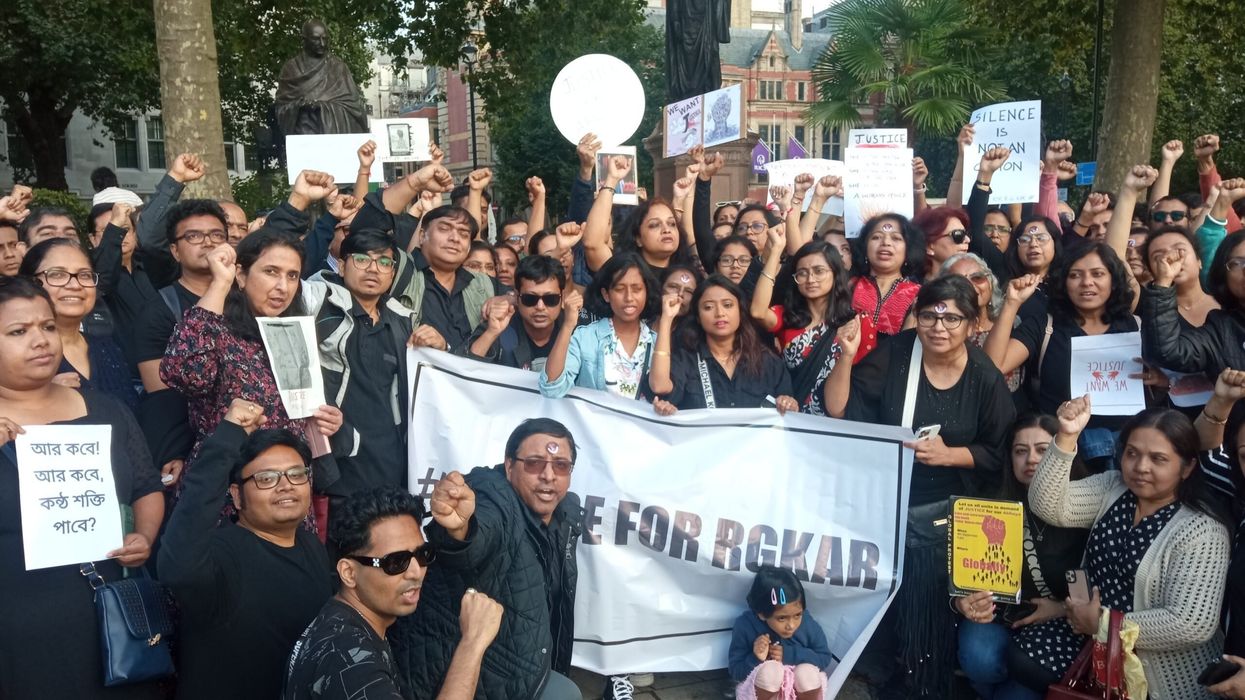THE exceptionally brutal rape and murder of a woman doctor in a Kolkata hospital has triggered widespread protest demonstrations across the global Indian diaspora, with the latest large gathering taking place in London last Sunday (8).
More than 200 people, mostly doctors and their families, gathered by Mahatma Gandhi’s statue in Parliament Square and summed up their demands in a single word: “Justice.”
Beyond calling for the culprit (or culprits) to be caught and punished, those demonstrating are also seeking fundamental reforms so that women are less vulnerable to sexual violence, a dark and persistent aspect of life in modern India.
Lalita Bisht and Bipul Kanri with their daughter Neha KanriRG Kar Medical College & Hospital, founded in 1886 by a local philanthropist, Radha Gobinda Kar, is a notable Kolkata landmark. It has trained many doctors who now serve the NHS in the UK. It is at RG Kar that Moumita Debnath, a 31-year-old doctor, finished a 36-year hour shift on the night of August 8 and retired after having dinner with colleagues.
Her body was discovered the following day, at 9.30am in a seminar room “in a semi-nude state with her eyes, mouth, and genitals bleeding”.
Her murder has triggered nationwide protests by medical staff, especially women doctors who feel they are particularly vulnerable during night shifts.
Gang rapes, in which the woman is killed, appear to be more common in India than almost any other country. A 22-year-old medical student, Jyoti Singh (nicknamed Nirbhaya – or fearless), was mercilessly and fatally gang raped by six men on a night bus in Delhi on December 12, 2012.
Four of the rapists were subsequently hanged for their crime. But even capital punishment has done little to discourage sexual violence in the country.
Some protesters in London who attended the demonstration at Parliament Square last Sunday recalled their personal experiences of working at RG Kar.
Nirmalya Chakraborty,Arpita Mandal, Anirban MandalLalita Bisht, who came to Britain in 2006 and now works at Worthing Hospital in Sussex as an anaesthetist, was clearly in a state of great distress as she told Eastern Eye: “For the last few days we couldn’t sleep properly. I did my post graduation from RG Kar from 1998 to 2000. I was imagining where this seminar room was, and how bad it would have been for the girl to go through (what she did). It is so unfortunate for the family.
“When I was in RG Kar, I felt very safe there. I used to finish my shift around 10pm sometimes and go home alone. Kolkata used to be a very safe metro city. We always thought it was very safe for girls, and I never felt I was unsafe.
“I was happy to ask for help from whoever was nearby and say, ‘Dada, (elder brother in Bengali), I am having this problem. Can you help me?’ And they used to help me out. Compared with north India, I felt so safe in West Bengal. I did my degree from Bankura Medical College. My dad was in the (Indian) army, so I moved around.
“Out of the four metropolitan cities, Calcutta (now Kolkata) used to be very safe for the girls. Even my brother, who is an army officer, told me, ‘You are very much used to asking help from strangers in Calcutta. Don’t do the same when you come to visit us in north India because it’s not the same here.’
“We are hearing more of it (reports of sexual violence against women) maybe. But when I was growing up or in medical school, we never heard of that type of incident, or it never came to our mind that someone is being like vulgar or someone has been sexually assaulted. Maybe things have changed over time. Although RG Kar was not my medical college (where I had done my first degree), I felt people were very welcoming. I have many friends whom I met in those two years and they are still very good friends.”
She added: “The culprits should be punished and the healthcare system – everywhere – should be safe for girls. We can keep our daughters or sisters safe in our house, but how can we feel safe when they are going out? We have to not feel frightened till they come home, but we have to be on our toes about what might be happening to them.
The poster announcing the protest“We have to create a safe environment for our society. And it’s not by teaching girls to become independent. It is teaching boys, how they can respect girls, and this should come from within the family.”
By her side was her husband, Bipul Kanri, a surgeon at Worthing Hospital, and their daughter, Neha Kanri, a pharmacist.
Kanri added to his wife’s account: “I did my post graduation from NRS (Nil Ratan Sircar) Medical College in Kolkata from 1998 to 2001. Things have gone so bad (in India) that they have to be corrected. They can’t be allowed to go beyond this and get worse.
“The solution is you need systemic improvement and accountability. Whoever is in authority has to take responsibility. There has to be not only safety and security, but also better education and training. There is a lot of corruption. You have to give a bribe to pass an examination. These things are inter-related to sexual violence.”
According to Anirban Mandal, a consultant plastic surgeon from Liverpool, “the short-term goal is demanding justice for this particular heinous crime of rape and murder. The medium and the long-term goal is ultimately to look at the root cause of this. This means revisiting healthcare in West Bengal and beyond, and creating a clean system. Trainee doctors are facing a lot of problems, at the moment, in terms of fighting corruption and mismanagement. There is a system, but it is not being implemented.
“When we were students and trained there, we never heard of these things in Kolkata or in West Bengal. Such crimes and corruption are completely unheard of. One part is that obviously we need justice for this (what has happened at RG Kar), but then you need a prevention strategy. Otherwise, this is going to repeat again.”
Nirmalya Chakraborty, a trustee in the UK of the charity Calcutta Rescue – this was set up by a British doctor, Jack Preger, who ran it in Kolkata for 40 years – said it works in the slums and with the poorest people in the city: “It provides free healthcare, education and improving living standards. We are building toilets, we are building clean drinking water stations. It’s not only about education, but also about gender equality. We work with other charities. One of them is Swayam which is about stopping violence against women. We have taken cognisance of this horrific incident within hospitality premises. We must not allow this to be forgotten.”
He described the country, especially north India, as a patriarchal society. He said even after the notorious Delhi rape of 2012, the parents of those convicted insisted: “Boys will be boys.”












